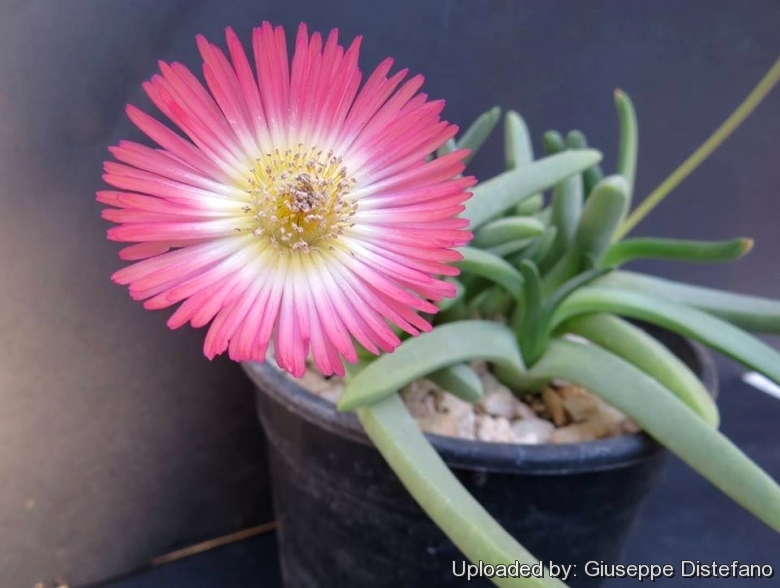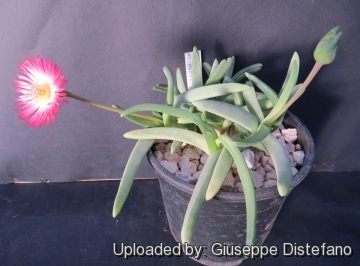




Your support is critical to our success.

Origin and Habitat: Cephalophyllum spissumSN|29964]]SN|29964]] is endemic to the Vanrhynsdorp Distristrict, Western Cape, South Africa.
Habitat and ecology: It grows on quartz together with Argyroderma delaetiiSN|33232]]SN|804]], Argyroderma pearsoniiSN|804]]SN|33232]], variosus Crassula species, Conophytum obcordellumSN|16149]]SN|16149]] and Brunsdgia orientalis. With an average annual rainfall mostly 100-200 mm the area is uncompromisingly arid for much of the year. The searing drought of summer is broken only occasionally by scattered thunderstorms. Cold fogs drifting inland from the frigid waters of the Atlantic herald the coming of autumn. Real relief from the drought comes only in winter when the first cold fronts blow in from the sea, initiating a spurt of growth. The area greens rapidly and is in full flower by early August.
Synonyms:
- Cephalophyllum spissum H.E.K.Hartmann
ENGLISH: Quartz mat-vygie
AFRIKAANS (Afrikaans): Kwartsvygie
Description: Cephalophyllum spissumSN|26026]]SN|29964]] is a slow, compact clumper with chubby, 5 cm long, 3-angled finger-like greyish-green leaves, anisophyllous when young (having the leaves of a pair different in shape and size). It blooms twice a year with showy flowers nearly 4 cm across, displaying unusual salmon-rose coloured silky-rayed petals and a showy white centre with colourful anthers.
Leaves: Three-sided, with sharp edges and concave sides, dark green from lack of wax particles, without a pustule, 45-60 mm long.
Flowers: Nearly 4 cm across with 110-150 purple to pink petals, base lighter, 200-420 stamens with yellow anthers.
Fruits: 12-14 mm in diameter, 11-15 locules, valve wings only a little wider than expanding keels, distal rim of covering membrane low, erect.
Seeds: Smooth.
Chromosome number: 2n = 18, 36.
Similar species: Distinguished from Cephalophyllum caespitosumSN|29964]]SN|26026]] in the same area by strictly compact growth and fewer branches, bigger leaves and fruits with a higher number of locules. Both species are often named "Cheiridopsis cupreaSN|26028]]SN|26028]]".
Bibliography: Major references and further lectures
1) Heidrun E.K. Hartmann “Illustrated Handbook of Succulent Plants: Aizoaceae A-E” Springer Science & Business Media, 2002
2) “Southern African Wild Flowers: Jewels of the Veld” Struik, 2004
3) Burgoyne, P.M. & Victor, J.E. 2005. Cephalophyllum spissum H.E.K.Hartmann. National Assessment: Red List of South African Plants version 2014.1. Accessed on 2015/01/05

Cephalophyllum spissum Photo by: Giuseppe Distefano
The gallery now contains thousands of pictures, however it is possible to do even more. We are, of course, seeking photos of species not yet shown in the gallery but not only that, we are also looking for better pictures than those already present. Read More...
Cultivation and Propagation: Cephalophyllum spissumSN|29964]]SN|29964]] is a rare & sturdy succulent which is completely unfazed by the neglect it receives in hot & dry corners. It is most active in winter, but in favourable growing conditions it keeps going over the summer too and doesn't need particular care. In cultivation this species seems to prefer a fairly dry rest in winter but grows whenever watered. In very dry warm regions these succulents make very impressive out door ground covers. The spectacular, brightly coloured rose and white flowers attract insects when the flowers open.
Growing rate: It is vigorous and quick-growing, speedily forming lateral shoots and low mats.
Soil: Requires good drainage as it it is prone to root rot. It can grows outdoor in sunny, dry, rock crevices (protection against winter wet is required) It can also be cultivated in alpine house, in poor, drained soil.
Fertilization: Feed it once during the growing season with a fertilizer specifically formulated for cactus succulents (poor in nitrogen), including all micro nutrients and trace elements diluted to ½ the strength recommended on the label. It thrives in poor soils and need a limited supplies of fertilizer to avoid the plants developing excess vegetation, which is easily attacked by fungal diseases.
Watering: They are not at all delicate and can take some water year-round. Water minimally in winter, only when the plant starts shrivelling, water more abundantly when they are growing in the spring, but let the soil dry between soaking. During summer, they still need some water eventhough they are somewhat dormant. If grown in a container, bottom watering by immersing the container is recommended. It must have very dry atmosphere.
Light: It needs a bright sunny or light shade exposure in winter, but keep cool and partially shaded in summer.
Hardiness: It prefer a very bright situation and require a minimum temperature 5°C, but can be cool to cold and dry in the dead of winter. The earlier in the year they are planted, the better the chances for winter survival. True with many of the Mesembryanthemaceae.
Maintenance: Pinch off spent flowers to encourage more blooms.
Uses: This popular, water-wise garden plan is an excellent plant for container growing. It always looks good and stays small. It look fine in a cold greenhouse and frame or outdoor in a rockery.
Pests & diseases: It may be attractive to a variety of insects, but plants in good condition should be nearly pest-free, particularly if they are grown in a mineral potting-mix, with good exposure and ventilation. Nonetheless, there are several pests to watch for:
- Red spiders: Red spiders may be effectively rubbed up by misting the plants every day.
- Mealy bugs: Mealy bugs occasionally develop aerial into the new leaves and flowers with disfiguring results, but the worst types develop underground on the roots and are invisible except by their effects.
- Sciara Flies: Sciara flies are one of the major problems for seedlings. It is a good practice to mulch your seedlings with a layer of grit, which will strongly discourage the flies.
- Scales, thrips and aphids: This insects are rarely a problem.
- Rot: Rot it is only a minor problem with mesembs if the plants are watered and “aired” correctly. If they are not, fungicides won't help all that much.
Propagation: It is very quick and easy to start from seed or cuttings. Seeds germinate in 7-14 days at 21°C in spring. To make a cutting twist off a branch with at least a part of roots and permit it to dry out a couple of days, lay it on the soil and insert the stem end partially into the soil. Try to keep the cutting somewhat upright so that the roots are able to grow downward. To enhance rooting success use a rooting hormone powder.
| Your Actions | |
|---|---|
| Back to Cephalophyllum index | |
| Back to Aizoaceae index | |
 |
Back to Succulents Encyclopedia index |
Privacy stantement - Terms and conditions - How to cite - About us - Feedback - Donate



